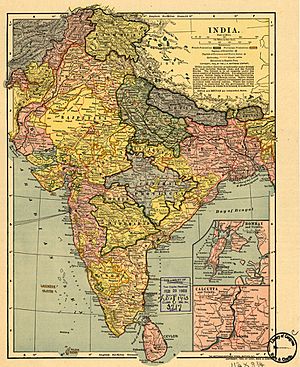Princely state facts for kids
A princely state was a special kind of state in India when the British ruled there. These states were also known as native states or Indian states. They had their own Indian ruler, but this ruler had a special agreement with the British. This agreement meant the British had a lot of power over them, a bit like a big brother watching over a younger one. This power was called "British Paramountcy."
The people living in these princely states were not directly subjects of the British Indian Empire. Instead, they were subjects of their own local ruler. If they traveled, their passports would say "British protected person." Because of their agreements, these states could not talk directly with other countries without the British saying it was okay.
Sometimes, the British would get involved in the internal affairs of these states, even if it went against their agreements. They often did this for their own safety or control. The Indian rulers and their people often protested this. They felt it was an unfair takeover of their state's independence.
Rulers and Their Titles
The rulers of these princely states had many different titles. Here are some common ones:
- Raja: This was a title for a Hindu ruling prince.
- Maharaja: This meant a greater Hindu ruling prince.
- Nawab: This was the title for a Muslim ruling prince, like the Nawab of Awadh.
- Nizam: This was the special title for the ruler of Hyderabad.
Princely States in 1947
In 1947, when India became independent, there were about 565 princely states. About 118 of these were considered "first-class" states. This meant they had their own governments. Only five of them were very large:
- Hyderabad
- Mysore
- Jammu and Kashmir
- Baroda
After India became independent, three of these large states joined the new country of India. The status of Jammu and Kashmir was debated for a long time.
Images for kids
-
An 1895 group photograph of the eleven-year-old Krishnaraja Wadiyar IV, ruler of the princely state of Mysore in South India, with his brothers and sisters. In 1799, his grandfather, then aged five, had been granted dominion of Mysore by the British and forced into a subsidiary alliance. The British later directly governed the state between 1831 and 1881.
-
The Govindgarh Palace of the Maharaja of Rewa. The palace which was built as a hunting lodge later became famous for the first white tigers that were found in the adjacent jungle and raised in the palace zoo.
-
Photograph (1900) of the Maharani of Sikkim. Sikkim was under the suzerainty of the Provincial government of Bengal; its ruler received a 15-gun salute.
See also
 In Spanish: Estados principescos de la India para niños
In Spanish: Estados principescos de la India para niños












